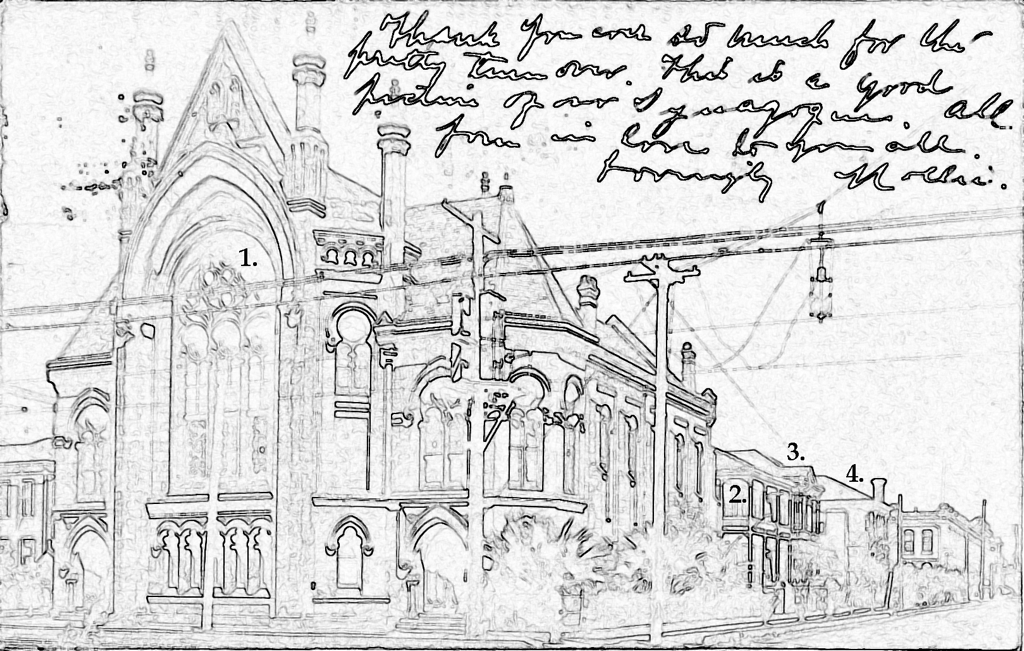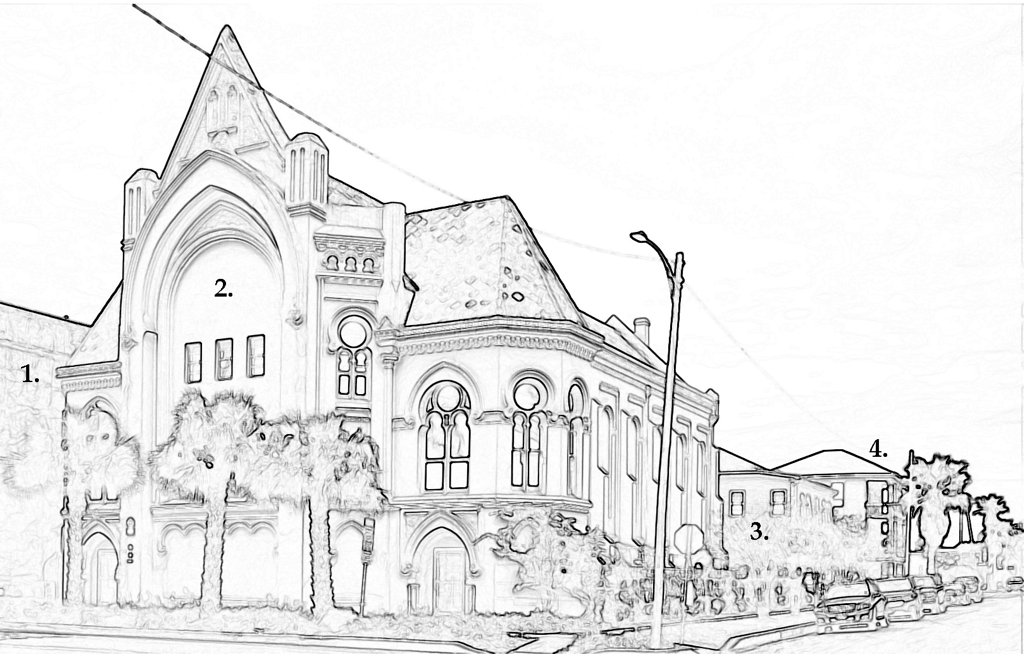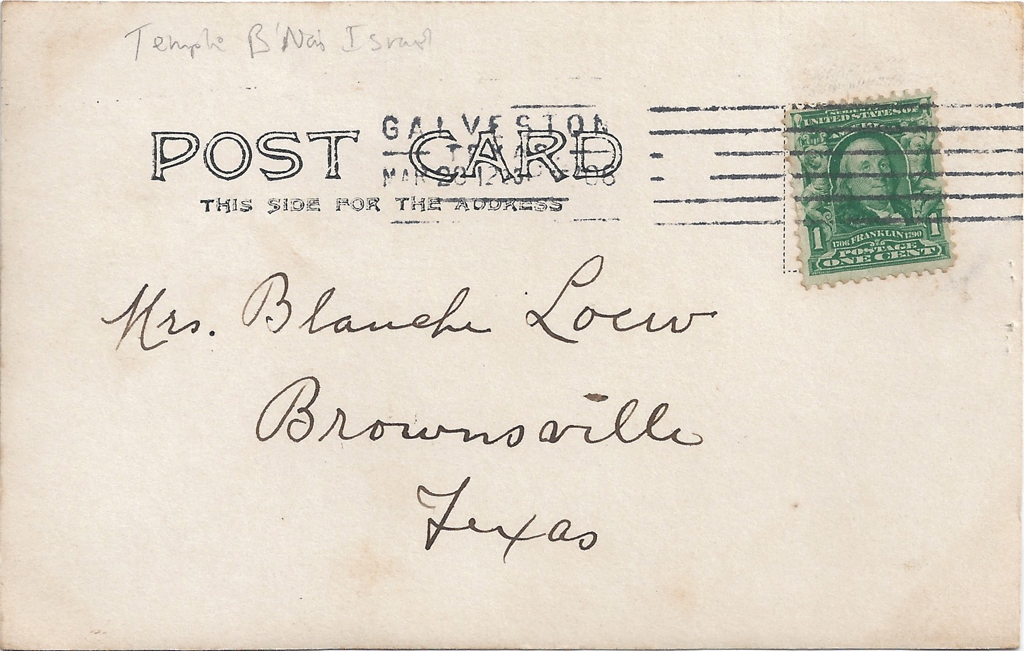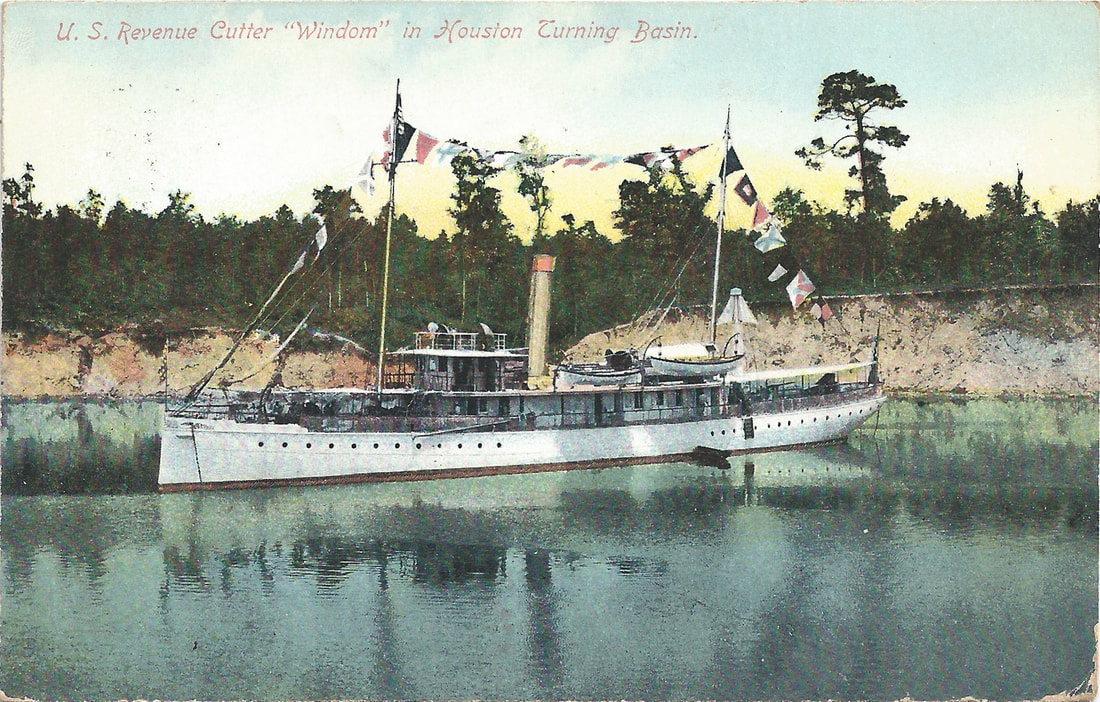Synagogue B’nai Israel
|
23 March 1906: 1. 822 Kempner (22nd ): The B’nai Israel Synagogue was built in 1871 with the main entrance on Sealy Street to the left. In 1887 Nicolas Clayton added the vaguely Neo Gothic entrance on 22nd, with a Levantine aspect to the building in keeping with the middle eastern ethos of Judaism; 2. 2120 Sealy (Avenue I): Tenants in the rental house next to the synagogue included sisters-in-law Maggie James Blagge (1846-1918) and Caroline Gibbs Blagge (1826-1909), wives of brothers Hamilton Blagge (1839-1909) and Henry W. Blagge (1838 -1899) who served in Company F of the 26th Texas Cavalry in the Battle of Galveston; 3. 2112 Sealy (Avenue I): The home of Isadore Lovenberg (1844-1917), notary public, commissioner of deeds, and Vice President of International Cresoting & Construction Company, and sons Samuel (1880-1927) and Isaac (1876-1914), former assistant attorney general of Texas; 4. 2102 Sealy (Avenue I): The house on the far corner was built in 1870 for Mrs. Emelia Gengler, occupied as a rental property in 1906. In 1908 the occupant was John K. Wiley, Jr., who had moved from the Herman Marwitz House at 801 Kempner (22nd) after his father died.
|
23 March 2019: 1. 814 Kempner (22nd): In 1928 the Henry Cohen Community House was built to the left of the synagogue honoring the revered Rabbi Henry Cohen. In 1955 the congregation abandoned the synagogue and moved to another building at 3008 Avenue O; 2. 824 Kempner (22nd): The old synagogue building became a Masonic Temple, architects removing most of the religious intent of the structure. This included truncating the corner tourelle towers, covering over of the striped banding in the arched labels above doors and windows, removal of much of the stained glass and bricking in the windows. Despite these defacements, the structure still stands out as one of Galveston’s most iconic remaining 19thcentury buildings; 3. 2120 Sealy (Avenue I): The house next to the synagogue was demolished and replaced in 1965 with a building that serves as apartments; 2112 Sealy (Avenue I): The house where the Lovenberg family lived was demolished and is now a parking lot; 4. 2102 Sealy (Avenue I): The Gengler House remains, the first level turned into a working floor, making the house technically three-story, though structurally unchanged from 1870.
|
|
Postmarked: 23 March 1906; Galveston, Texas
Stamp: 1c Blue Green Ben Franklin #300 To: Mrs. Blanche Loew Brownsville Texas Message [Front] Thank you ever so much for the pretty turn over. This is a good picture of our Synagogue. All form in love to you all. Lovingly Mollie. Blanche Loew was a 48-year-old widow of Leopold Loew, a jeweler by trade. He was born in Strasbourg, France in about 1841. When he came to America is not certain, but he is first found in the United States in Houston in 1877 when he married Blanche Wolff. She was the daughter of Arthur S. Wolff, a French-born physician, and Sarah Ansell from Dublin, Ireland. Arthur was a highly qualified physician, born in Lyon, Rhône, France in 1819, son of Doctor Simeon Wolff, a noted Parisian physician. Arthur was educated at Montpelier School in Paris, graduating with a Bachelor of Letters and two medals for proficiency. He obtained his medical degree from the French Academy of Medicine and Surgery, and served as physician in the French Army in 1846 with the French Zouaves in their successful attempt to conquer Algeria, for which he obtained the Legion of Honor. He then obtained a second medical degree at Leyden, Holland and began a private practice in London, where in 1850 he married 21-year-old Sarah Ansell and had four children before immigrating to America on the verge of the Civil War (a son Simon was born in 1853 and died in London at five years of age). Arthur came to America first, entering Ellis Island, New York on the Africa on June 9, 1859. The rest of the family followed on the Jason on 2 November 1859: his wife Sarah, her sister Amelia, and children Caroline (5), Arthur, Jr. (3), and Blanche (11/12).
In 1861 he joined the 3rd brigade of the 55th Regiment of the New York Volunteers and was stationed in hospitals in Washington. After the war he was appointed physician at Clinton Prison in far northeast NY where his daughter Leah was born in 1876, last in a line of 8 children, joining American-born Estelle (1866), Jesse C. (1870), and Ernest (1874). Soon after the family moved to Brownsville where Texas Governor Richard B. Hubbard had appointed Dr. Wolff as Brownsville State Quarantine Officer, serving there through the 1882 Yellow Fever epidemic and other medical crises. Blanche was about 20 years old when she married Leopold Loew, and they had a son Harry Kalman Loew in Houston in 1878. By 1880 they had relocated to Atlanta, GA where Leopold continued in his jewelry business at a shop at 60 Whitehall, living a few blocks away at 57 East Peter Street on the southwest side of town. Tax records show that Leopold moved to Albany, Dougherty County, GA about 1885, and there he died in 1895 and is buried in Oakview Cemetery. Blanche and her 17 year old son had long been in Brownsville by this time, living with her father’s family as her son Harry went to public school in Brownsville. He graduated UT Medical School in Galveston in 1901, then a second MD from Columbia University, NY and 2 years residency at New York hospitals. In 1904 he was Assistant City Bacteriologist at Hartford, CT, but he would ultimately return to the Rio Grande Valley to practice medicine. Blanche lived with her father in Brownsville, but may have met her correspondent through her son Harry when he was in medical school in Galveston. Since both women were Jewish, they had additional connections through their religion. Mollie cannot unambiguously be identified, but there were few women by this name in Galveston in 1906, and if she was not a short-termer there, separating those of Jewish faith can be done with the a searchable archive, the Jewish Online Worldwide Burial Registry [JOWBR]. Of those who were buried in Galveston, only three seem likely candidates: 1) Mollie Cohen (1879-1945) was buried in Beth Jacob cemetery founded by an orthodox congregation, and thus not likely a member of B’nai, a reformed synagogue; 2) Mollie Bronstein (1861-1926) was also buried in Beth Jacob, and also perhaps not likely the author of the postcard; 3) Mollie Cohen (1862-1951) buried in Hebrew Benevolent Society Cemetery, was the Texas-born wife of the Rabbi of B’nai, Dr. Henry Cohen, and most likely of the three to be the author of the postcard. Until a handwriting sample of Mollie Cohen can be located for comparison (quite likely, it seems, since her husband’s papers are archived at the University of Texas), she is tentatively identified as the author of the postcard. |
Dr. Henry Cohen was born in London, England in 1863 and was educated at local schools and Jews’ College where he graduated in 1880. He had worked as a translator in Cape Town, Africa before being ordained as a rabbi in 1884. His first assignment was in Kingston, Jamaica, then in 1885 at Woodville, MS, a small town of less than 1,000 citizens between Natchez and Baton Rouge, LA. In 1888 he came to Galveston, a city of 30,000 with a deep history of Jewish participation stretching back to the foundation of the port city in 1816. Dr. Cohen became Rabbi at B’nai Israel, and married Mollie Levy in 1889.
Mollie was the daughter of Minna Posner and Isaac Levy, who immigrated from from Strasbourg, a city on the eastern border of France and Germany, in about 1860. The family first settled in Boston, MA, then New Orleans, LA, where the children are found in 1860 with Mrs. Mary Samuels, perhaps as guardian: Louis (7), Jenny (5), Adolph (2), listed with the surname of Samuels. Isaac and Minna have not been found on this census, and perhaps were in transit between New Orleans and Galveston, where they finally settled by 1870, where Mary “Mollie,” Martha, and Marx were born. [Alternatively, Isaac may have been caretaker for the three Samuels children from New Orleans.] Isaac lived above their retail store at 116 E. Market where they sold pictures, frames, moldings, wood and willow ware (1886), as well as toys, notions, and “fancy goods” (1888). The Levy family was active in B’nai Israel activities, I. C. served as treasurer for the congregation and for the Hebrew Benevolent Society, and Minna was treasurer for the Ladies Hebrew Benevolent Society. Isaac died in 1889 and was buried in the Hebrew Benevolent Society Cemetery, Minna died in 1898 and is buried beside her husband. After the 1900 storm devastated the island, Texas Governor Joseph D. Sayers appointed Rabbi Cohen to head the Central Relief Committee to deal with the crisis and help maintain order in the city. By this time Dr. Cohen had become an unstoppable force for a wide range of progressive interests in Texas. He was active in prison reform, pushing rehabilitation for convicts while serving on the Board of Prisons at the behest of Texas Governor Dan Moody (governor 1926-1928). When the Ku Klux Klan planned a march on Galveston Island, Rabbi Cohen blocked them at the causeway bridge, and when he ascertained the U. S. Navy had no Jewish Chaplains during World War I, he lobbied to get special legislation to allow rabbis to serve. He was instrumental in the Galveston Movement, a drive to divert Jewish immigrants fleeing Russian and Eastern European pogroms from crowding into poverty-stricken city streets in New York and other East Coast cities. Rabbi Cohen met ships at Galveston docks and helped the immigrants through the cumbersome arrival process and assisted their distribution into the countryside. These efforts to extend his pastorage beyond the small confines of his Jewish parish did not go unnoticed. Mrs. Eliza Seinsheimer Kempner, a generous parishioner and heir to the fortune of her husband, Harris Kempner, a Galveston banker, cotton factor, and wholesale grocer, donated a home to the congregation at 1920 Broadway for the use of the rabbi. Mollie and Henry had two children: Ruth (1890) and Henry Isaac (1893-1956). Dr. Arthur S. Wolff died in 1904 and was buried at Hebrew Cemetery in Brownsville. The family stayed at their home on Washington Avenue (1910): widow Sarah Wolff, Blanche Loew, Bernard Cain, husband of Blanche’s sister Leah, their son Lambert Benel Cain and Blanche’s son Dr. Harry Kalman Loew. Harry served in WWI, finishing out his commitment at Camp Travis in San Antonio, TX where he is found with his fellow soldiers in 1920, soon returning to Brownsville to become the City Health Officer. Blanche’s mother died in 1923 and joined her husband in Hebrew Cemetery as Blanche came under the protection of her bachelor son, taking his father’s place as one of Brownsville’s leading citizens. They lived in the old part of Brownsville in a house next door to the widow Josefa Trevino, whose husband Manuel Trevino de Los Santos Coy as Mexican consul hosted Porfirio Diaz at the house in 1875 where he formulated his plot to overthrow the Mexican President Sebastian Lerdo de Tejada. Porfirio would succeed in 1876 and hold the presidency until 1911. Harry died in 1932 after a thorn driven into his ring finger during a game of golf lead to a blood infection and a fatal septicemia. Blanche died in 1949 and was buried in Brownsville’s Hebrew Cemetery that would come to hold so many of her family members: father Dr. Arthur Samuel Wolff (1819-1904), mother Sarah Ansell Wolff (1832-1923), sister Jesse C. Wolff (1870-1882), brother Ernest Wolff (1874-1880), sister Leah Wolff Cain (1876-1963), brother-in-law, Bernard Lee Cain (1864-1933), niece Jessie Blanche Cain (who died in 1894 as an infant). Blanche’s nephew Lambert Benel Cain graduated West Point in 1919 and after a distinguished military career in WWI and WWII was buried at Arlington National Cemetery in 1990 at the age of 91. Mollie died in 1851 and Henry died in 1952 and they are buried in Hebrew Benevolent Society Cemetery in Galveston. Their daughter Ruth, a talented pianist and writer, married Rabbi Ephraim Frisch in 1916 in New York City. Ephraim Frisch, an immigrant from Lithuania, had served as rabbi in Pine Bluff, AR and Rockaway, Queens, NY, before founding the New Synagogue at 41 W. 86th street in Manhattan shortly before their marriage. In 1923 he was sent to Temple Beth-El in San Antonio, but his outspoken views led to much controversy. Ruth died in 1934 of Hodgkin’s lymphoma and was buried beside her parents in Galveston. Her brother Henry Isaac Cohen died in 1956 and is also buried there. Ephraim Frisch’s sermons criticizing compulsory Bible readings in schools, advocating a boycott of the 1936 Berlin Olympics, and his various stances favoring The New Deal and Filipino independence led to the congregation voting him into retirement in 1942. He returned to New York an embittered widower and spent his last days there. In 1957 he died and was buried in Mount Hope Cemetery in Westchester County, NY. |





